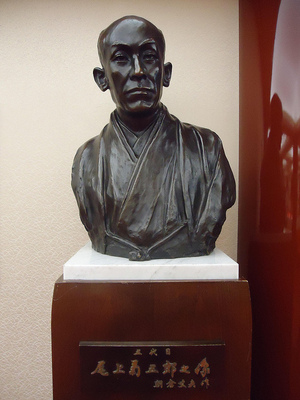Onoe Kikugoro V

Onoe Kikugorô V one of the three most popular and influential kabuki stars of the Meiji period, along with Ichikawa Danjûrô IX and Ichikawa Sadanji I.
He was famous for a number of roles, including Benkei in Kanjinchô, Benten Kozô in Aoto Zôshi Hana no Nishiki-e, and Oiwa and Kohei in Tôkaidô Yotsuya Kaidan. Kikugorô also collected his favorite dance-dramas into a list known as the Shinko engeki jûsshu.
Names and Lineage
Like most kabuki actors, Kikugorô went by a number of different stage names over the course of his career. He debuted as Ichimura Kurôemon, and spent time as Ichimura Kakitsu IV and Ichimura Uzaemon XIII before taking the name Onoe Kikugorô in 1868. Kikugorô's yagô was Otowaya, and he also used the poetry names Baikô and Kakitsu.
Kikugorô was the son of Ichimura Takenojô V, and grandson of Onoe Kikugorô III and Ichimura Uzaemon XI. Bandô Kakitsu I was his brother.
Kikugorô had two sons, Onoe Kikugorô VI and Bandô Hikosaburô VI, and two adopted sons, Onoe Kikunosuke II and Onoe Baikô VI. The late Nakamura Kanzaburô XVIII (d. 2012), one of the most prominent actors of the late 20th & early 21st centuries, was a great-grandson of Kikugorô V; his sons, Nakamura Kankurô VI and Nakamura Shichinosuke II, still active today, are among Kikugorô V's many great-great-grandsons active in kabuki.
Kikugorô also had many disciples, including Onoe Matsusuke IV, Onoe Matsusuke V, Onoe Kikujirô III, Onoe Fujaku VII, Onoe Shinchi IV, Onoe Kikujûrô III, Onoe Kôzô II, Onoe Monzaburô IV, Bandô Muraemon I.
Career
Kikugorô began his stage career in 1848/11, at age four, as Ichimura Kurôemon. Three years later, he took the name Ichimura Uzaemon XIII and was named head of the Ichimura-za (though, presumably, his father continued to handle the actual work of managing the theater).
In 1862, Uzaemon performed in the premiere of the play Aoto Zôshi Hana no Nishikie (also known as Shiranami Gonin Otoko), debuting the character of Benten Kozô.
He took the name Kakitsu IV the following year, and then became Onoe Kikugorô V in 1868/8. In 1869, he became zagashira (head) of the Nakamura-za.
Kikugoro performed at the Shintomi-za in 1879, in a special gala reception for Gen. Ulysses S. Grant, and two years later, in June 1881, in the premiere of Tsuchigumo by Kawatake Shinshichi II, a production organized in commemoration of the 32nd anniversary of the death of his grandfather, Onoe Kikugorô III.
A private production held at the residence of Minister of Foreign Affairs Inoue Kaoru on 26 April 1887 was organized for the Meiji Emperor. This would be the first time any Emperor viewed a kabuki performance; Kikugorô starred alongside Danjûrô IX and Sadanji I.
Kikugorô continued to perform in numerous premieres, including the opening of the Chitose-za in 1885, the premieres of Botan Dôro and Makura Jidô in 1892, and that of the kabuki adaptation of Hagoromo in 1898.
He appeared on stage for the final time in November 1902, at the Kabuki-za, playing Benten Kozô in Chûshin Kanagaki Kôshaku. He died the following February.
References
- "Onoe Kikugorô V," Kabuki21.com.